Assassin's Creed Shadows: The Off-Balance Review.
A blade cannot be forged without fire.
This review will discuss Assassin’s Creed Shadows in depth, from gameplay specifics to major story and character elements.
Please consider this your spoiler warning.
And in the interest of transparency, it bears underlining that I am not paid by, affiliated with or professionally familiar with Ubisoft or any entertainment outlet in any capacity.
This review, in its totality, is my own.
As always, thanks for reading Off-Balance! Until next time,
Ryan.
Table of Contents
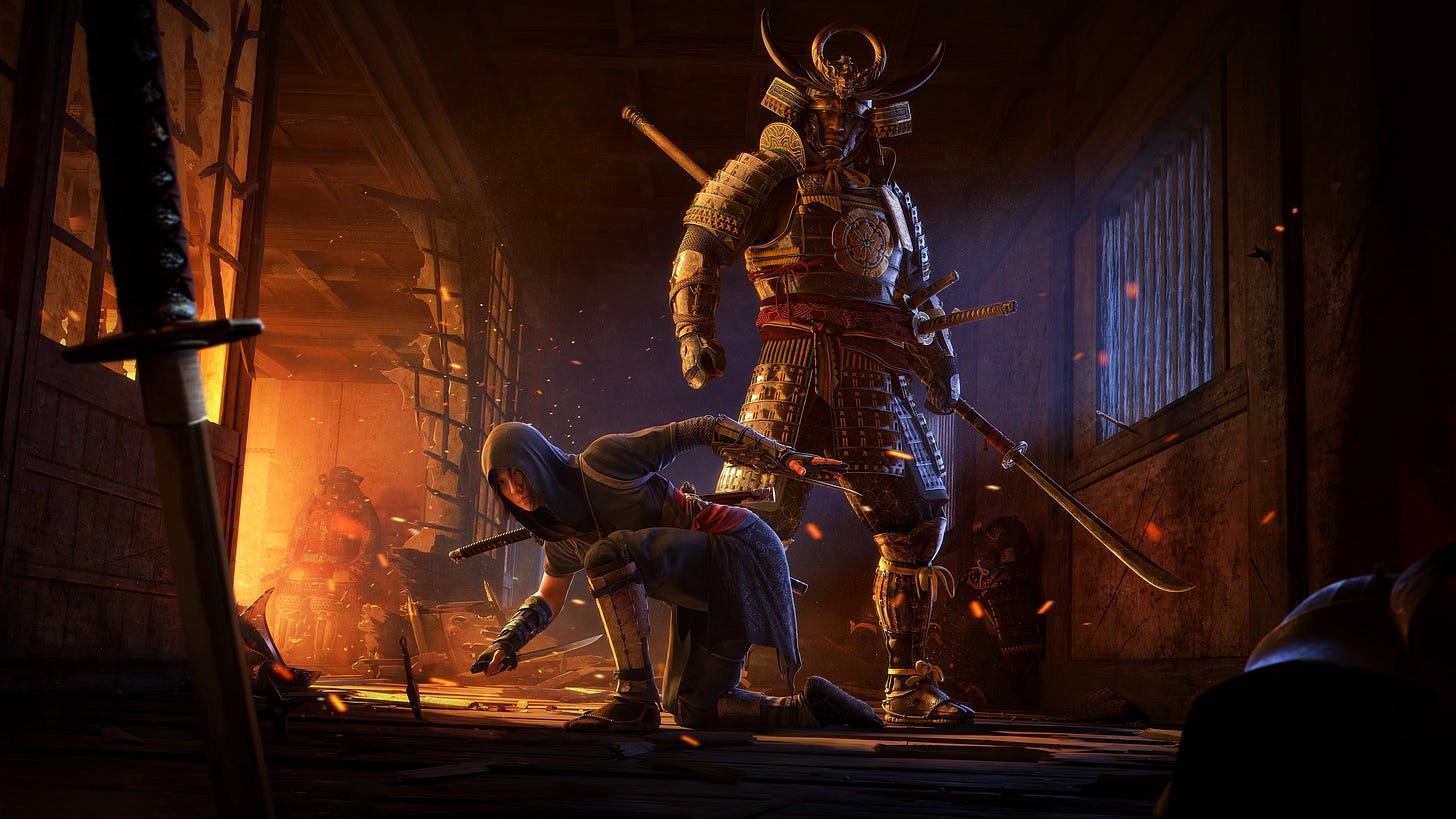
No franchise, especially in gaming, can totally exist in a vacuum.
The medium, inherently, invites evolution at such a rapid pace, to stay completely stagnant is to disappear.
The resilience then, of Ubisoft’s Assassin’s Creed, given that understanding, is particularly fascinating.
Be it the melding of genres and styles, from historical to high-concept science fiction, the multi-levelled lore or the simple reality of its sheer staying power. Since its debut, in 2007, the series has undergone no less than three distinct gameplay evolutions and has expanded into various other mediums, despite, almost paradoxically, sticking to a noticeable sense of individualism, backed though it is, by one of the largest developers on the planet.
One of those evolutions, evidently, was finally heading to Japan.
Once shot down as a possibility by Ubisoft, for nearly fifteen years now, it has been a oft-requested setting from long-time fans, considering how well such a choice would seemingly fit the established framework (secret societies, hoods and blades, etc, etc).
And with Assassin’s Creed Shadows, which arrived late last month, it was to see that vision realized.
Primarily developed by Ubisoft Quebec, Shadows, delayed twice, was also the subject of various controversies prior to release (though the loudest dissent, as it was, was started by the bigoted worst of the always-online contingent), this, during what became an expanded marketing push, even by Triple-A gaming standards (to say nothing of Ubisoft’s much-discussed financial state eventually resolved, it seems, with a billion-dollar-plus subsidiary buyout).
Not without gameplay shortcomings, noticeable structural and technical missteps or indebted, though it may be, to its predecessors: even as the fourteenth main entry in the series, where it matters most, Shadows stands strongly on its own, successfully ushering in the next era for AC.
Intro (Shadows)
In the late 16th century, the man who will become known as Yasuke (Tongayi Chirisa), arrives far from his homeland on the shores of Japan, as an unwilling footman to a band of Jesuit missionaries (Yasuke, of course, being based on the real-life historical figure of the same name).
Sensing greatness in him however, Yasuke enters the service of the daimyō Oda Nobunaga (Hiro Kanagawa), an influential warlord who is relentless in his ambition to have all of the country unified under his banner.
Trained as a samurai, Yasuke, though haunted by the horrors of his past as a slave, becomes both a highly skilled warrior and quickly proves himself as Nobunaga’s right hand, helping him fend off dissent on all sides.
Elsewhere, in the self-sustaining province of Iga, is Naoe (Masumi Tsunoda). A young woman who, while being tutored in the ways of combat and stealth by her father Nagato (Peter Shinkoda), begins to suspect there is more to her lessons than simple self-defense or the just protection of their people.
Though when Nobunaga invades Iga, only later to be usurped and betrayed, it unleashes a net of conspiracy so wide it threatens to engulf Japan whole. Seizing control of the country from the shadows, are a group known only as the Shinbakufu, their goals, mysterious but their methods, putting innocent lives at risk.
Finding themselves then, in equal opposition, Yasuke and Naoe become the most unlikely of partners, where, alongside a collection of newly-formed allies, they commit themselves to working together, to safeguard peace and put an end to the Shinbakufu’s schemes.
But as they do so? It is to learn their place in a seemingly isolated conflict has a history far richer than either one of them could have ever imagined.
So while Shadows’ set-up may recall the general supports of the series’ previous titles, it also looks, early on, to establish its own distinct feel - and nowhere is this more apparent than with the game’s combat and stealth mechanics.
Combat + Stealth
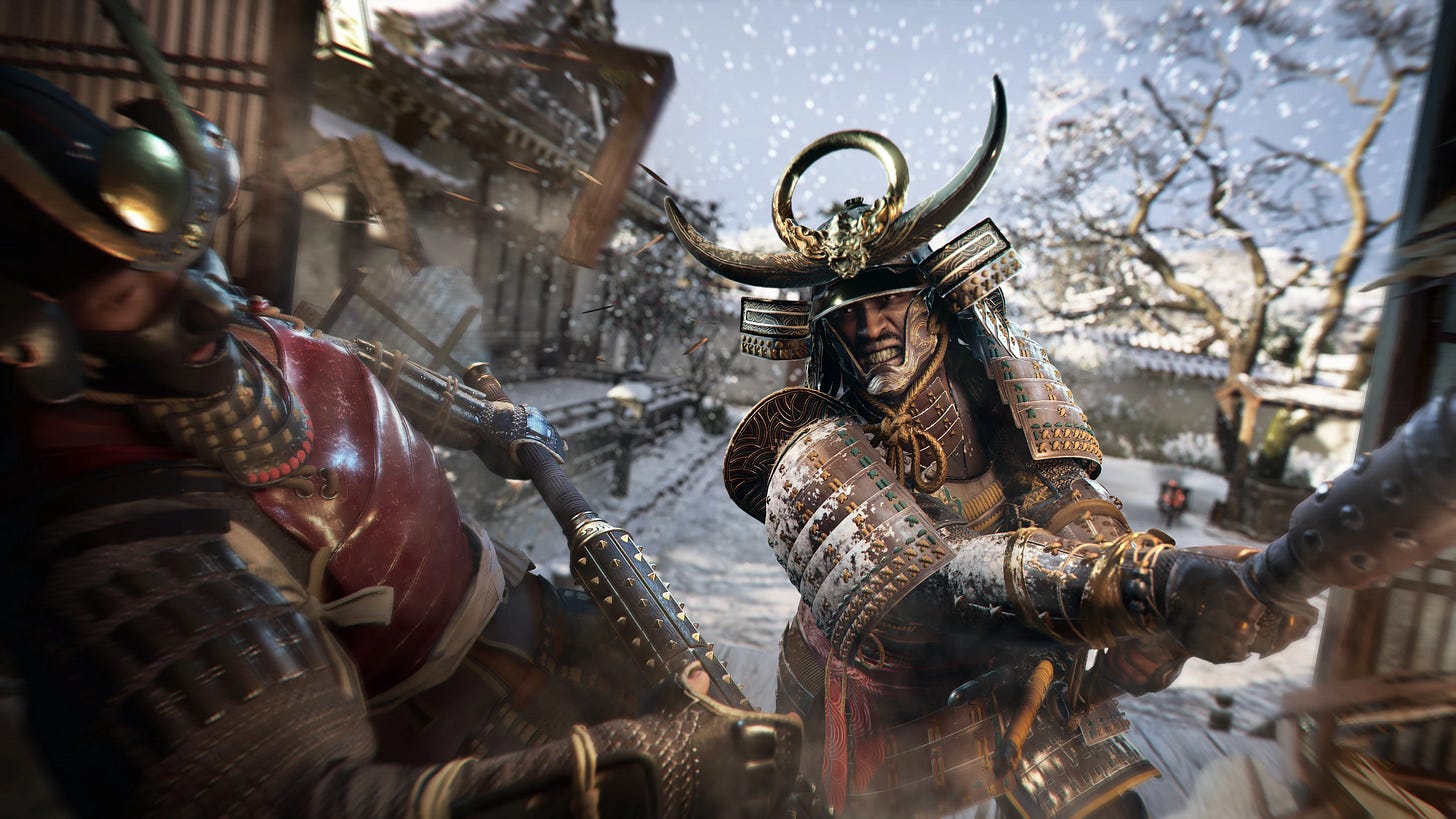
While the dual-protagonist system is not a wholly new addition for the series, what sets Shadows immediately apart is within its moment-to-moment execution.
The approach featured in Revelations, for example, was exclusively narrative-driven and while there was animation diversity present in III, again, as something primarily narrative-focused it wasn’t game changing. And a decade on now, from 2015’s Syndicate, while the Frye twins did have some noticeable variation in their respective gameplay styles, as Assassins proper, they were jacks-of-all-trades.
The lessons learned by Quebec since then however, as the returning lead studio from Syndicate and Odyssey both are clear. Feeding directly into what are, on launch, perhaps the franchise’s most complete, deep and polished combat-stealth systems.
Shades of what the original nine games brought to the table, with their general stealth-first focus alongside the more warrior-build, combat-driven RPG-blueprint that has been the standard since 2017’s Origins (Mirage, being the exception).
Instead of looking to strike a middle ground however (something, for example, that Valhalla noticeably struggled with) it continually circles back to the characters as a whole and the differences that define them.
Yasuke, the front-facing samurai, Naoe, the ninja, who is at her best when working from stealth.
Each then, with their own weapons, armour sets and multi-tiered skill trees highlight those two AC styles, while still expanding outwards, with a notable sense of individualism (even when up against inevitable comparisons to say, Sucker Punch’s 2020 samurai-stealth title, Ghost of Tsushima).
The dodge-parry system is still the base for both but it feels far more grounded and purposeful when compared to its RPG-era predecessors, even with a touch of hack-and-slash.
For one, the moment-to-moment balancing has been replaced with what the game dubs “flurry attacks”. Primarily dealt by Shadows’ tougher foes (samurai, shinobi, Guardians and mini-mission bosses), these attacks, delivered in rapid succession under a tight window, must be parried/deflected consecutively. Doing so successfully will stun an enemy, opening them up for a tool or posture attack. This, done by holding down either right trigger, light or heavy, to deal a significant amount of damage with whatever primary weapon is currently equipped.
Similarly, in time, both protagonists have will have opportunities for recourse against what are initially unblockable attacks but that advancement, just because it is an option, it doesn’t make the player totally untouchable either: while character-specific diversions alter it in practice, Yasuke, delivering a direct parry, Naoe, deflecting to the side before using that space to deliver a hard slash, instead.
Though in clear response to the “damage sponge” criticism that has been present in the RPG-tiles since Origins, higher-level enemies wear armour, a more visible application of the two-health bar system, more so when compared to Valhalla’s stamina management. Deal enough damage and an enemy’s armour will shatter and break apart, not just a noticeable pseudo-realistic detail but leaving them vulnerable too, in opening up their health bar.
Abilities return as well, still mapped with a trigger-button press but unlike Odyssey and Valhalla, they don’t play as prominent, necessary-to-use roles in the overall combat flow, more supporting power punches than active cards in the player’s deck.
Though with the proper skill point investment, the area-of-effect abilities can prove quite useful, particularly when fighting larger groups or if caught in an under-levelled skill-check, needing then, to rapidly whittle away at an enemy’s health bar to maintain an advantage.
More broadly, inventory management is blend of both Odyssey and Valhalla. Gear and armour are still collected at random in the open world but to far less of an extent than was the case in Ancient Greece, while the one-of-a-kind legendary gear can be sequentially upgraded, alongside their engravings, at the blacksmith found at the player’s hideout (in addition to an at-launch transmog system).
While in a returning series staple, as Yasuke and Naoe move through Japan, they will recruit specific allies to their cause, each, with particular skills that the player can call on, for both combat and stealth assistance.
These are one-use abilities with extended cool downs but levelled-up, they can shape any one encounter or help to tip the scales if overwhelmed, even if they aren’t woven that tightly into the game’s combat fabric (oftentimes, one might forget they’re there).
But beyond this mostly shared base, it is where the similarities end.
Even their default finishers are radically different, reflecting the characters in ability and personality. Naoe, with flourish and efficiency, Yasuke, with brutal precision.
For, in all facets, the combat-first playstyle was designed with him in mind.
Deeply committed to the samurai arts, he has more health, can take more damage and with his weapon set, even as the series has drawn on such an approach before, gives a whole a new meaning to going in loud.
Pick up enough speed when moving towards castles or keeps and Yasuke will barrel straight through doors, tearing them right off their hinges, startling his opposition and giving the player a moment to strategize before an entire garrison swarms in.
His abilities reflect this, highlighting the character’s strength, able to take out numerous standard enemies with ease or zeroing-in on a specific mission or activity-based target.
To this end, he has the widest weapon availability between the two protagonists, as well. While the katana, primarily built for duelling, is a great all-around weapon, the naginata is best for crowd control, particularly, again, when in castles or restricted areas packed with enemies. The wide area-of-attack, keeping the player on the offensive as much as possible: even if one must trade off some dexterity to use it effectively.
Outlining the kanabō’s practical application though, is a little tricker.
Incredibly heavy and slow to use, it can tear through armour during a one-on-one showdown and take out standard enemies with hardly any effort but given Yasuke’s more limited mobility, it can quickly leave the player exposed when up against a group, where timing and awareness can make all the difference, this, heightened on the highest two difficulties.
It can be fun to experiment with, though its usage comes with some semblance of a learning curve, if one choses to designate it at as their go-to.
For ranged weaponry, the bow returns, though it doesn’t have the raw attack power of the previous RPG games. Building out the bow-specific skill tree can prove effective when looking to pick off certain targets from a distance prior to stepping into any encounter proper but its usage in combat, even centred around abilities, feels like less of a get-out-of-jail free card then it has been previously: no doubt, a matter of personal preference.
The teppō, similarly, can be used to start off encounters with a bang but given its default standing - slow reload and single-shot capability - it doesn’t have much use when in the thick of a fight, although some engravings can boost its efficiency.
Yasuke does have the option though, unlike Naoe, to switch weapons mid-combo: meaning if the player wants to put all those tools to use, such as finishing off an enemy in style with a teppō ability after a hard-won duel, they can do so, without it feeling too clunky.
Ultimately, what Yasuke’s combat gameplay puts forward is a power fantasy close but far different than what Odyssey and Valhalla presented. Yes, either as an immortal, Piece of Eden-wielding warrior or a supercharged viking, those games had power in spades, But they were also designed around build management, as is RPG standard, meaning there was inherently some trade off, in focusing on whatever path the player chose to prioritize, especially in Odyssey. That is still present in Shadows but from the jump here, Yasuke is greatly formidable in open combat, to a much higher degree.
That, in contrast to Naoe.
By default, sure, while Shadows’ resident shinobi is viable out in the open, the game very much advocates a glass cannon approach. She has less health, compared to Yasuke, less effective health restoration and if the player goes in recklessly, she can be downed in just a few hits.
Speed and space are essential, dodging, deflecting and vaulting over enemies to stay on the offensive to not give up an inch of ground. This, even deep into the game, when her fundamentals would be long mastered.
She can handle a couple bandits or a lone enemy with no trouble but larger groups, of soldiers and samurai present an immediate, difficulty-spiking challenge (though more so, as expected, in the early going when the systems are new).
Speaking to this, her generally lesser combat capability, Naoe has just three weapons at her disposal, to Yasuke’s five: the katana, which is nicely balanced for virtually all encounters, the kusarigama, for crowd control and the tantō, which she uses in tandem with her Hidden Blade for close-quarters confrontations. Though the kusarigama, admittedly, often felt like something of an afterthought and didn’t see much usage, over the course of this review (why put oneself into a situation requiring crowd control as a character who is not geared towards tackling it in the first place?)
Develop Naoe’s respective skill trees however, and that feeling of claustrophobia does lessen. As mentioned, the katana can be further built-out to deliver counters and a tantō-based ability, “Hidden Hand”, will see Naoe perform a standard assassination in open combat, a measure of breathing room if spotted during a stealth run.
For that is where she truly shines, in a most amusing oxymoron: in the shadows.
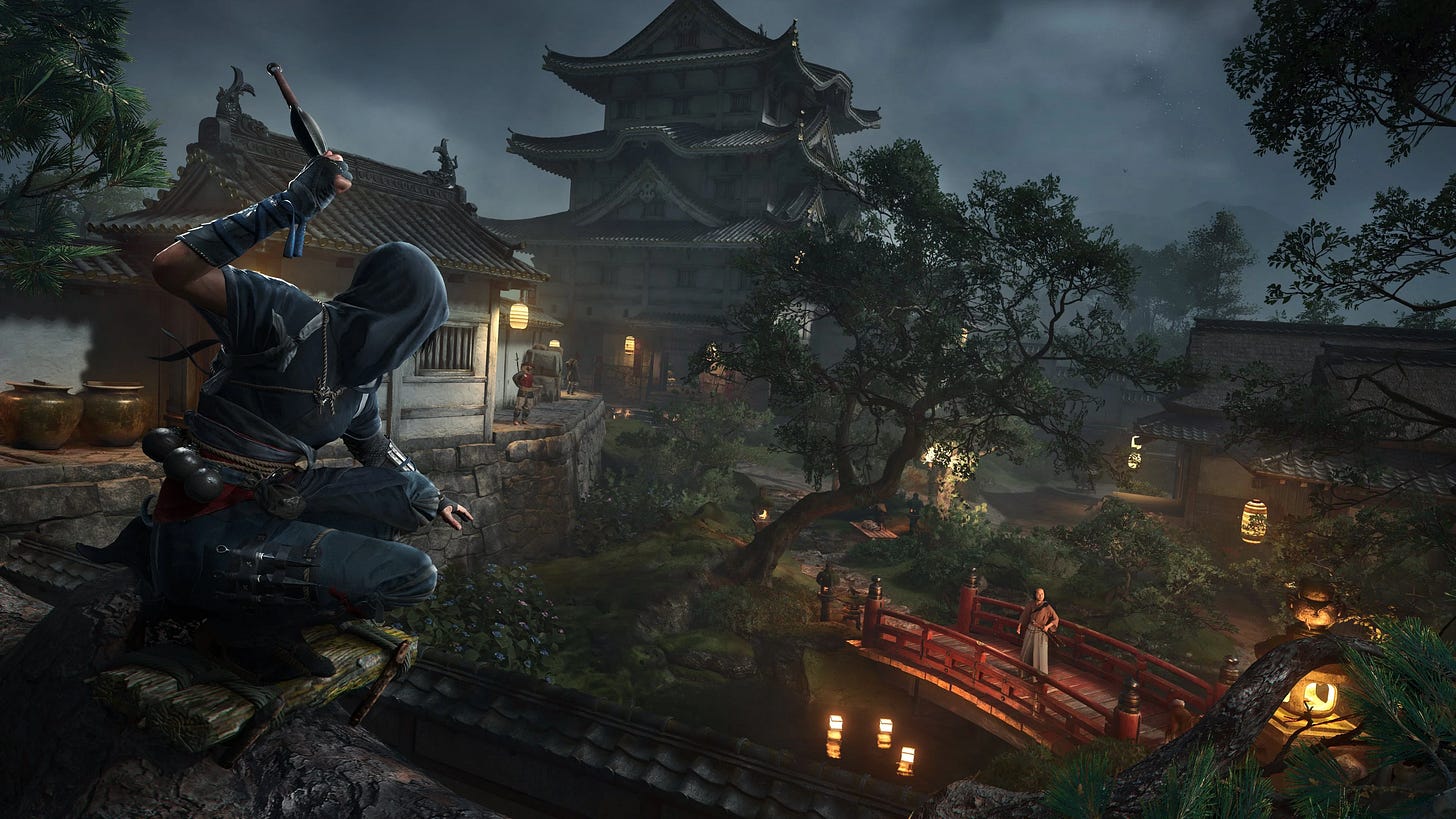
Perhaps in an effort to keep control in the player’s hands, although Assassin’s Creed made its name on being stealth-first, the series’ first era of games never pushed the concept too far, either.
By design, the protagonists were practically superheroes, a cut above any of the goons they would usually be going up against, able to blend into any crowd, utilizing a host of applicable tools and never being all that challenged, as players settled into a groove of whistling, waiting and striking.
The fundamentals have been retained in the RPG-era but in primarily moving away from tightly-knotted city loops, it has taken on a far different flavour. Social stealth doesn’t return in Shadows, after its reintroduction in Valhalla and Mirage but the game does bring its own unique stealth parameters to the table, starting with, well, actual shadows. Crafted organically in the environment, they encourage the player to stick to the walls, the perimeter or the rooftops in any one infiltration.
Built out from this, lanterns and light sources can be extinguished to put the player on the advantage in more well-lit areas, while Naoe can grapple to highlighted ceiling pivots to get the drop on unsuspecting enemies. The classic hiding spots (wells, bushes, haystacks, etc) are still there but this time, they aren’t the be-all-end-all, the creating of one’s own opportunities being more openly encouraged.
While Yasuke has hardly any stealth options besides his bow (even his assassinations, tagged “brutal”, are loud as hell), Naoe’s tools, simple and functional, reflect something akin to the series tapping back into its distract and disappear philosophy.
Bells can be used to both isolate individual targets or draw a group together, kunai, sequentially upgraded, can pull off one-hit kills from distance, while shurkien can both stun and be used on specific environmental objects (such as lights and castle bells) to either disorient before striking or to slip back into darkness unseen.
Smoke bombs, unsurprisingly, are more situational and their usage must be considered more carefully than in past titles: some enemies, on contact, will step directly out of the resulting cloud, meaning the player must move quickly, especially if they’re working against a well-numbered group or plotting an escape.
Successful assassinations, again, by default, are tied to blocks of health damage in Shadows but the system feels much more mechanically fleshed-out when compared to its RPG predecessors. Guaranteed assassinations, as in the days of old are still there (to be turned on in the options menu) for those who want them but slowly building up Naoe’s competency with the Hidden Blade is very satisfying from both a gameplay and character development standpoint.
Enemies that can’t be taken down in one hit are clearly marked and if the player tries anyway, Naoe will be physically overpowered, visibly miss her mark entirely or some combination of the two (an undeniable step-up from Odyssey’s half measure kills or Valhalla’s more drawn-out animations).
It pushes players to consider, beyond investing in her Assassin skill tree as they go, a certain element of strategy for a good portion of their playtime.
Working the room, as it were, to eliminate as many soldiers or lower-level enemies as they can before moving in on those who can’t be taken down silently, this, expanding on Shadows’ other depth-driven decisions.
Unlocking specific skills for both the katana and kusarigama can allow them to be used in certain stealth conditions, while one skill in the tantō tree, for example, will grant the player, as long as the tantō is equipped, the ability to pull off double assassinations alongside the Hidden Blade (that sound you hear is series veterans rejoicing in unison, with classic one-two double assassinations returning for the first time in ten years).
Though after its usage felt increasingly diminished and stripped back in Valhalla and Mirage both, the avian familiar has been retired in Shadows, putting players back fully on ground level. Only the traditional version of Eagle Vision, AC’s sixth sense, returns in Shadows and then, only for Naoe.
Allowing her to tag, track and follow enemies through walls, while the observe mechanic, available for both protagonists, best used from a vantage point, can, with a hold of the left trigger, scout an environment for mission objectives and/or specific targets (it clicks well enough but the lack of full, pre-engagement reconnaissance for Yasuke can be frustrating).
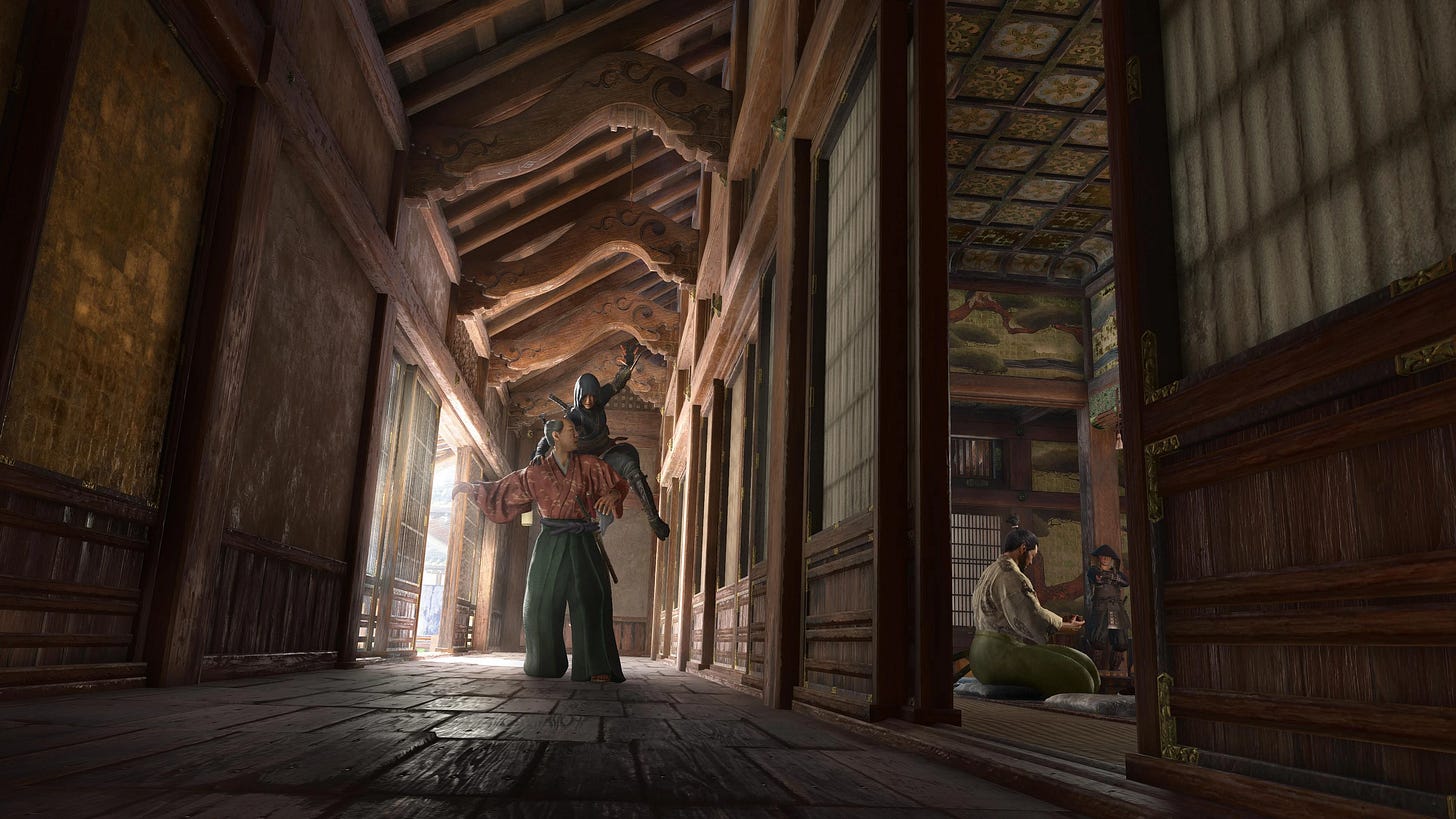
One new addition to keep an eye on are servants, unarmed eyes-and-ears who roam the grounds of the most heavily fortified camps and castles and will alert surrounding guards if they see the player (though as Naoe, they can be dealt with non-lethally) and nightingale floors that require absolute precision to move across without being discovered.
The meditation feature, at launch, has been removed meaning the inherent benefits found in nighttime infiltrations won’t always be available, forcing players to take on more risk during the day if they wish to go undiscovered.
During winter, foliage, cover, is less present, while falling icicles, if a rooftop is navigated hastily, will alert guards below to the one’s presence. And on the game’s highest difficulty, all these factors must be taken into account. Roofs aren’t always safe, guards will look up, search longer and from noise to tools used, stealth is, while not quite unforgiving per se, definitely more rewarding, if one is looking for a significant challenge.
Yes, the RPG-levelling in Shadows’ combat and stealth can feel tedious at times, noticeably near the endgame and with all the enemy archetypes presented right from the get-go, active strategy development stalls, roughly, around the midpoint.
Exploitation and familiarity can creep in as a byproduct, once one becomes in-tune with the systems, with nothing inherently baked-in to prevent such drops, other than the player engagement (such as turning the difficulty, as mentioned, up a couple notches).
But with the depth and new additions they bring to the AC sandbox, these systems are wins across the board. The motion capture team, the animators, the stunt team, each brought a different facet to life and did so very well to boot, in creating two distinctive playstyles.
Moving beyond that however, is to step out into the game’s most visible pillar, that being, its open world recreation of 16th century Japan.
Open World + Exploration
Since its inception, the Assassin’s Creed franchise has prided itself on its impressive open worlds, in both detail, specific scope and overall fidelity, Shadows, being no different.
The first AC title to be exclusively released on the current (ninth) generation of hardware, it takes full advantage of the heft such an upgrade of processing power provides, presenting what is one of the series’ most visually dynamic titles.
From the improved hair and cloth physics or the more cinematic energy brought forth in fully performance captured cutscenes and facial animation (after these elements were visibly stiff in Valhalla and Mirage), though the centrepiece feature, above all, is the changing seasons.
Grouped into phases, the game rotates between all four once the designated bar on the map-screen is full, after specific in-game actions (completing major missions, fast travelling, etc) with each brought to life with artistic flourish and a dash of gameplay consideration: from the limiting of stealth opportunities in winter (as discussed) or the visual shifts from spring and summertime into autumn.
The wind, the rain, the lighting, dense forests, the overarching weather effects and the sound design accompanying them, they all work together in tandem, a credit to the teams behind those efforts. From wandering the snowy streets of Kyoto or riding through a village, chocked with desolation as it finds itself torn apart by war.
It has been over a decade since the series presented any sort of seasonal weather system and the art design alone sees Shadows stand out, helping to keep Japan visually and sonically fresh (this, next to the composition work by The Flight and TEKE::TEKE). The fourth game now, to fit into the series’ RPG-mold, Shadows clearly builds off the pre-existing template, Odyssey, most prominently, which tracks given their shared developer, though with a few touches of its own.
Enemy camps to be cleared, assassination contracts to be completed or character-specific tombs to be raided. These are all returning activities and while they fit well enough into the open world flow, the new additions get more of a spotlight. Temples and shrines dot the landscape, providing very light collectible hunting in exchange for upgrade points or opportunities for prayer and reflection.
Yasuke and Naoe each have individual QTE-activities they can undertake, speaking to a specific point of their character, from meditation to kata, while both can complete sumi-e. These see them create ink paintings of certain animals they encounter during their travels across Japan (this, the game’s primary animal interaction function, with both hunting and animal aggression being excised), which can later be hung throughout their shared hideout (while others can be added to freely roam around the space).
The idea here is to get both the characters and the player to slow down. To stop, if only briefly, to pause and take in the world or view it through a different lens, one that doesn’t involve violence, bloodshed or extended combat encounters.
And for the most part? This vision is communicated to effect.
Castles hold pieces of legendary gear sets, though in trimming down Odyssey’s multiple-item checklist for full completion, they require less specific item collecting but instead, a substantial amount of legwork: requiring up to five individual targets to be eliminated, across a wide expanse of fortification, before the gear chest is available to loot.
Some castles are better suited to infiltration as one character or the other but there is, generally, no limitations on who the player chooses. Each, bringing their unique playstyle to the board in an effort that feels worthwhile… most of the time. Part of the challenge is needing to scope out the area, of course but without clear markers, it can frequently be disorienting and unnecessarily so.
Base-building returns as well but unlike every previous title which has featured the mechanic, in Shadows, the farmstead that Naoe and Yasuke use as their hideout is totally, nigh-completely customizable by the player. Buildings, pathways, trees and foliage or the large inventory of cosmetic items, they can be placed, rearranged or deleted however one sees fit.
Many buildings offer passive gameplay bonuses, so even though the hideout doesn’t have anywhere close to the same level of narrative weight as was previously shown (consider, Assassin’s Creed III, which remains the benchmark) or if one doesn’t have much interest in indulging that creative impulse, it is still worthwhile to return periodically, to refresh, create and check in with the duo’s ever-growing roster of allies.
On the movement side, parkour specifically, for Naoe at least, has seen a return of sorts to the classic form. While Yasuke, given his build and combat-exclusive training is not a parkourist whatsoever and has very minimal options in this space, given her background as a burgeoning-Assassin-to-be, Naoe is, without question, the most fluid, fast and agile protagonist in the series thus far.
Her grappling hook, a clear spiritual successor to Syndicate’s rope-launcher, gives players a tool that pushes for verticality whenever possible, while her elegance sees her as the sole protagonist, of the two, who can correctly perform a Leap of Faith (Yasuke, can jump into bodies of water and hay bales from height, to be fair but rather humorously, it is absolutely not a defined skill in his toolbox).
Looking for handholds, planning routes and assessing environments on the fly, these all return, to an extent, after being, fittingly, absent throughout most the RPG-era, given their respective settings.
However, these elements are almost entirely limited to execution in castles and enemy camps, as Japan, even including Kyoto, is just not a parkour-heavy environment wholesale: so while Shadows’ parkour may stand out amongst the RPG titles for the influence it draws from earlier AC games it isn’t entirely a worthwhile exercise, in comparing it to anything from that era.
Though despite these highs however, it is when actually engaging with the world, beyond the general strokes, where Shadows noticeably stumbles.
Unable, in totality, to innovate on its foundation in ways beneficial of its extended runtime.
On one hand, it is understanding that repetition is unavoidable in any video game, particularly the larger third-person tentpole efforts that are not just medium commonplace but specifically, the Ubisoft standard.
Where the more expansive AC outings generally curtailed this feeling though, was in sheer variety.
Open world activities that were engaging for the majority of any one playthrough, paired with visible movement identifiers. Be it III, Black Flag, Rogue, Odyssey or even Valhalla, which, held back by bloat and undercooked mechanically though it was, for better or worse, offered something new to do around almost every corner.
Of course, the common denominator between virtually all of those titles is their naval traversal, which inherently made sure no one location or activity ever grew too stale. Feeling the grind set in on land? Well, take to the sea (far less so, it is true, in III and Valhalla).
Now, it wouldn’t be entirely fair to put this up as a complete strike against Shadows. The reality of traversing the environment of mainland Japan means there is no need for anything ship-based, instead retaining the AC RPG markers of moving through the world almost exclusively on foot or horseback.
But there is just not enough dynamism to support this framework.
Simply put, once one acclimatizes to the visual beauty of feudal Japan, it is to see there just isn’t much to actually hook them there, outside of story progression.
This, a world that has a small offering of activities, repeats them constantly and given the inaccessibility of good portions of the map, the player quickly finds themselves locked onto main roads, following the waypoint marker, with no variation or self-driven exploration.
Safehouses, that can be unlocked from the map menu for the cost of in-game currency are used as fast travel points, in addition to synched viewpoints. And as one’s time in Japan grows, it shouldn’t be surprising to see them utilized with increasing frequency, if only to cut down the monotony that can come to define traversal.
Of another point is the game’s technical state.
In-series, Unity’s 2014 launch was so infamously chaotic, for many, it remains the broader talking-point for the title but Shadows, the first game built for the new generation, as Unity was then, clearly benefited from its extended development period.
On either performance or quality mode, be it prioritizing graphical fidelity or framerate, the game runs smoothly, with no nightmare-fuel inducing bugs as so popularized by Unity or the roughness that was present throughout say, Rogue and Valhalla.
But during the course of this review, on a standard PS5, despite that general thumbs-up, hard crashes in the hideout were a near constant presence, be it through base building, entering or exiting the hideout or simply moving through the space for an extended period.
The game’s first major update, released in early April did lessen this somewhat, by unlocking the frame rate but a more-or-less game-breaking bug, present in the hideout, during the second-to-last cutscene of the campaign, seemingly wasn’t ironed out. Completely locking progression and preventing any advancement whatsoever, it necessitated a complete uninstall-reinstall in the hopes that it would be bypassed but… it wasn’t.
Forcing what was then, in a dispiriting end to the initial Shadows experience, a migration to YouTube to see the final moments of the game’s epilogue to its conclusion.
And while instinct may push to knock down Shadows a significant degree because of this, it also serves as something of a reminder.
From Unity and Jedi: Survivor to the crash, burn and later resurrection of Cyberpunk 2077, playing any game in the immediate post-launch period means taking that risk, that the time spent could be sullied by technical performance issues or an abundance of bugs. And again, other than this seemingly very specific, location-based instance, during the near 130 hours spent in Shadows here, no other major issues really arose, save for the occasional framerate dip on performance mode.
Months from now, no doubt or even by the time of publishing, these issues will be patched and ironed out but that doesn’t excuse their presence in the moment, either.
So while its overall open world loop may stagnant, the high points of Shadows’ story are, generally, much more consistent.
Story

Taking place during a notably busy period in the AC timeline, while Shadows pulls strongly on a handful of series threads, particularly come its final act, it leans more visibly into the historical fiction angle alone when compared to its three direct predecessors: which all dabbled, to varying degrees, in the First Civilization/Isu, sci-fi side of the franchise. None of that is shown here, at least, at present, in the base game.
This particular time in Japan was rich with history all its own and that is reflected in the story Shadows chooses to tell, albeit still, with that AC-style spin.
After carving her way through the opening ranks of the Shinbakufu in revenge, mistakenly believing Nobunaga to be their leader, Naoe learns she has been played.
Akechi Mitsuhide (Kevan Ohtsji), a former member of Nobunaga’s inner circle and himself a member of the group let her loose, in attempt to usurp Nobunaga, having grown disgusted, so he later claims, with his crusade of violence in the name of peace.
So as Nobunaga, realizing his back is against the wall, despite Yasuke’s pleas, commits suicide (the entire sequence, a fictionalized deception of the real-life Honnō-ji Incident), it leaves Naoe, as she is, rageful as much as she is lacking purpose.
Coming to put her initial animosity aside however, she is later convinced by Yasuke that they can do more good united, as they set out to protect Japan and end the Shinbakufu’s schemes, albeit, for very different personal reasons.
Yasuke, to honour his daimyō and Naoe for the memory of her loved ones, while also looking to retrieve “The Box”: a classic AC McGuffin she was charged by her father to protect, before his murder.
But as they do so, bigger forces come into play.
Holding close both her father’s dying words and the weapon he gave her, Naoe dubs her group of allies “The League of the Hidden Blade”: grateful for the weapon’s use and what it represents to her personally but unknowing of the larger history she carries on her wrist.
Her own investigation however, alongside a series of flashback sequences, come to show, naturally, that her father kept the true purpose of their training together a closely guarded secret.
For Nagato, like Naoe’s long-deceased mother Tsuyu and their friend-turned rival Hattori Hanzō (Nobuya Shimamoto) were all Assassins. Their Brotherhood’s mission, besides upholding The Creed, was to safeguard the Imperial Regalia. One of which, The Box, Naoe, eventually recovers, fulfilling her promise to her father in the aftermath of the Shinbakufu’s destruction, via her and Yasuke.
Though as Hanzō, having reluctantly guided Naoe from afar, comes to reveal, he was the one responsible for the Japanese Brotherhood’s utter decimation and the Regalia’s loss to the Shinbakufu in the first place.
His unrequited love for Tsuyu, coming to cloud both his relationship with Nagato and his judgement, as he betrayed his people out of personal spite.
Though initially furious, Naoe offers Hanzō both her forgiveness and a place at her side, in the League. Grateful, Hanzō confirms another secret: he believes Tsuyu to be alive and tells Naoe that, when the time is right, they will find her together, in carrying out the legacy of their shared work.
Some may take issue with this, more broadly, having the Assassins (or depending on one’s title of choice, Hidden Ones) exist on the comparative periphery of the story once more but it is, on its own, an interesting application of a long-simmering idea.
In 2009’s Assassin’s Creed II, AC oldheads might recall, Altaïr, writing in his Codex, proposed that even if all adherents of The Creed were killed, the ideals they believed in, they would live on, eventually to be rediscovered by another. Naoe, though having Brotherhood-adjacent skills is not an Assassin in name but comes to see The Creed her parents fought for aligns with what she and Yasuke have established with their League. Ensuring that the Brotherhood’s battle against tyranny will live on, under a different name sure but flying the same banner.
A reach perhaps but in that spirit, as Yasuke cuts down the Shinbakufu, in tandem with Naoe, he slowly comes to realize they are not the true masterminds vying for control of Japan.
Someone else, something else, is pulling the strings, a group whose ambition cannot be quenched by mere power alone but rather, control, in all its forms… The Templars. Yasuke, coming to uncover the existence of a Portuguese branch of the Order led by the soulless slave trader Nuno Caro (Paulino Nunes), that has been making inroads in the country, caring nothing for its people or their safety in pursuit of dominance and profit.
But for Yasuke, dismantling their network and assassinating Caro, it goes well beyond fulfilling his sense of justice.
While his flashback sequences primarily focus on his coming-of-age journey during his samurai training, throughout his journey, Yasuke also grapples with what goes mostly unspoken prior: that, what brought him into the Jesuit’s orbit, to Japan, in the first place.
Though as he brings the Templars to task and confronts Caro head-on, it comes to light.
Once a slave alongside his mother on a Portuguese Templar ship, after Caro callously killed his mother, Yasuke was spared the same fate only by the timely intervention of an Assassin hunting the Templars, thereby buying him time to escape.
Though as he did, he swore, one day, he would avenge his mother, no matter the road taken.
So as Caro dies by his blade, Yasuke tells him that, while one mission may be complete, the next has just begun. He and his allies, they will destroy the Templars, fighting their injustice however they can to protect the people of Japan.
And this is where Shadows main narrative ends, with pronouncement in one hand but with a relative cliffhanger in the other.
Odyssey, one might remember, did something similar, only properly concluding two of its main storylines, while leaving the third open-ended, as to funnel players into its DLC episodes. Shadows, presumably, will follow this blueprint. The game has at least one major expansion, Claws of Awaji, set for release sometime later this year and the easy money then, would be on Naoe’s story being further explored there.
Frustrating yes but par for the course, considering the now-set reality of playing a game in the glow of the modern post-launch window.
It doesn’t take away, totally, from what Shadows’ story does well, however. It just means, for now, it must be viewed through a specific lens of knowing there is more to come.

Though in an effort to appease, it seems, both elements of the fandom, the pre-and-post RPG crowds, the game features what it calls “Canon Mode”.
That being, selecting it removes any and all RPG-esque choices for the player (dialogue choices, potential romance or smaller storytelling branches) instead presenting Shadows’ narrative in a totally linear, unbroken fashion, save for choosing which character to play as, during specific story moments.
That was the decision made for this review, although it must be understood that Shadows as is isn’t the wide-reaching RPG that say, Odyssey was: missing out on these choices doesn’t feel like a lesser or shafted experience (with one or two exceptions).
The crux of the game though, the second act, hunting down the Shinbakufu, is centred around, once more, the objective board feature. Presenting to players a certain non-linearity, the freedom to choose which targets to prioritize at any given time.
It is a solid enough idea in theory but in practice, it does lend the game a certain feeling of emotionless hit-listing, of which it is not the first AC game, in fairness, to struggle with. Many of the larger side mission chains follow this approach as well, which ultimately robs them of much of their personality, targets to eliminate and little else besides.
Now, many arcs are bookended with solid character work and narrative heft, as are most of the smaller missions encountered in the world, from the ally recruitment to more person-to-person stories but within the larger flow, they aren’t given as much a spotlight as they could have been.
The very best AC villains, the charismatic Haytham Kenway (Adrian Hough), the power-mad Cesare Borgia (Andreas Apergis) or the unstoppable force-of-nature that was Alexios (
), each was kept in sight during their respective stories.Not quite so, in Shadows.
While Nobunaga is presented very well, as the prologue-to-first-act villain, once his arc concludes, there is no legitimate overarching antagonist to chase, to keep the vast majority of the moment-to-moment story truly focused, until the end. The Shinbakufu come to be unmasked yes but primarily as an accelerant, to completely shift the spotlight to Yasuke’s Templar hunt and Naoe’s search for answers.
It is a set-up that fulfills its purpose but no doubt could have been sewn more consistently, into the tapestry.
Meanwhile, in the modern day, well… there isn’t much to report on.
A mysterious entity known as The Guide occasionally speaks to the player, as they move through Yasuke and Naoe’s memories, sharing with them how the Assassins’ cause came to find its way to Japan, while musing on free will and the human condition, amongst other things, including their opposition to another entity known only as Ego.
This is all meant to be the lead-in, evidently, to the “Animus Hub” feature Ubisoft has been promoting in recent months, a common area for the series to exist in going forward.
But even if it peaks some measure of baseline curiosity, after the genuinely interesting status-quo reset that concluded Valhalla’s modern day, of which nothing of that game is built upon here, this feels like little more than colourless stopgap.
Shadows then, it pushes most of its narrative chips into its first and third acts, next to its flashback sequences: tightly scripted and linear, with well written dialogue and highly cinematic supports. It is the absolute best of the game’s storytelling, even if, ultimately, it comes to lack a touch of momentum at the very end.
The supporting cast however, do what they can to keep that investment present, even with somewhat limited screen time.
Performances (Supporting)

Like Valhalla before it, the meat of Shadows’ story structure means it doesn’t necessarily spotlight a consistent supporting cast. As one arc finishes and the next begins, a new set of characters will come to assist Yasuke and Naoe in their quest, with no particular overlap.
In saying that however, there are a few characters - and through them, performers - that stand out.
In Assassin’s Creed custom, while there are many historical figures featured in Shadows, some take on bigger roles than others. One being Peter Shinkoda as Nagato, the leader of the shinobi in Iga. He cuts a believable figure as a man who is both weathered by the burden of duty yet almost reluctantly steadfast in his commitment to it. Though he later recognizes, too late, how his love for his daughter, Naoe, has caused him to lapse, driven more to protect rather than truly teach.
He does tutor her in the ways of their people it is true but it is under a veil of secrecy. Emotionally close though they may be, he still keeps her at a distance, not speaking of her mother, his history with Hanzō nor the responsibility of their family heritage, as Assassins.
Yet as Iga falls, as he dies in Naoe’s arms, Nagato realizes he has done all he can, trusting her to take those next steps alone. But what makes Shinkoda’s performance click? It is that this all feels genuine.
A father, a parent, just trying to do what he believes to be the right thing, warmth but heartache too.
Though in opposition to Nagato, there is Hiro Kanagawa, as Oda Nobunaga.
Nobunaga remains a prominent figure in Japanese history and from the moment he appears on screen, Kanagawa captures the enormity such a presence would dictate.
He sincerely believes in his mission to unify the country but understands it will not be a task easily won, from the competing forces of unsteady allies and rivals both. Others see what his campaigns have wrought, mass death and destruction and while Nobunaga has respect for the persistence of those who refuse to bend the knee, the Igans, most of all, he is unwavering in his pursuit.
Greatly impressed with Yasuke from their first meeting, he values his insight, as someone who can view his court from an outsider’s perspective, coming to see in him, in the midst of warring and squabbling underlings, as his closet equal.
It presents than, a solid dichotomy.
Charisma and grace, existing in equal measure alongside a keen, unforgiving ruthlessness. This, playing into the contrast of how Yasuke, Naoe and for the entire first act, the player, view him. Yet in his final moments, Nobunaga acknowledges his humanity, a man, betrayed, his purpose, lost. Even finding a dash of sympathy for Naoe as he does, upon realizing that she too has been deceived.
Kanagawa hits all these notes so strongly, the absence of the character from the rest of the story, historically accurate though it may be, is noted. No other antagonist, even the Templars, can quite match up in the same way.
Elsewhere, Nobuya Shimamoto conveys Hanzō’s duelling feelings of grief, anger and unrequited love well, despite not having too many opportunities to do so, while among the League’s many allies, Mackenyu, as the rouge thief Gennojo, plays up a good back-and-forth with Naoe.
But the brightest stars in Shadows’ ensemble?
It is the title’s leads.
Performances (Leads)
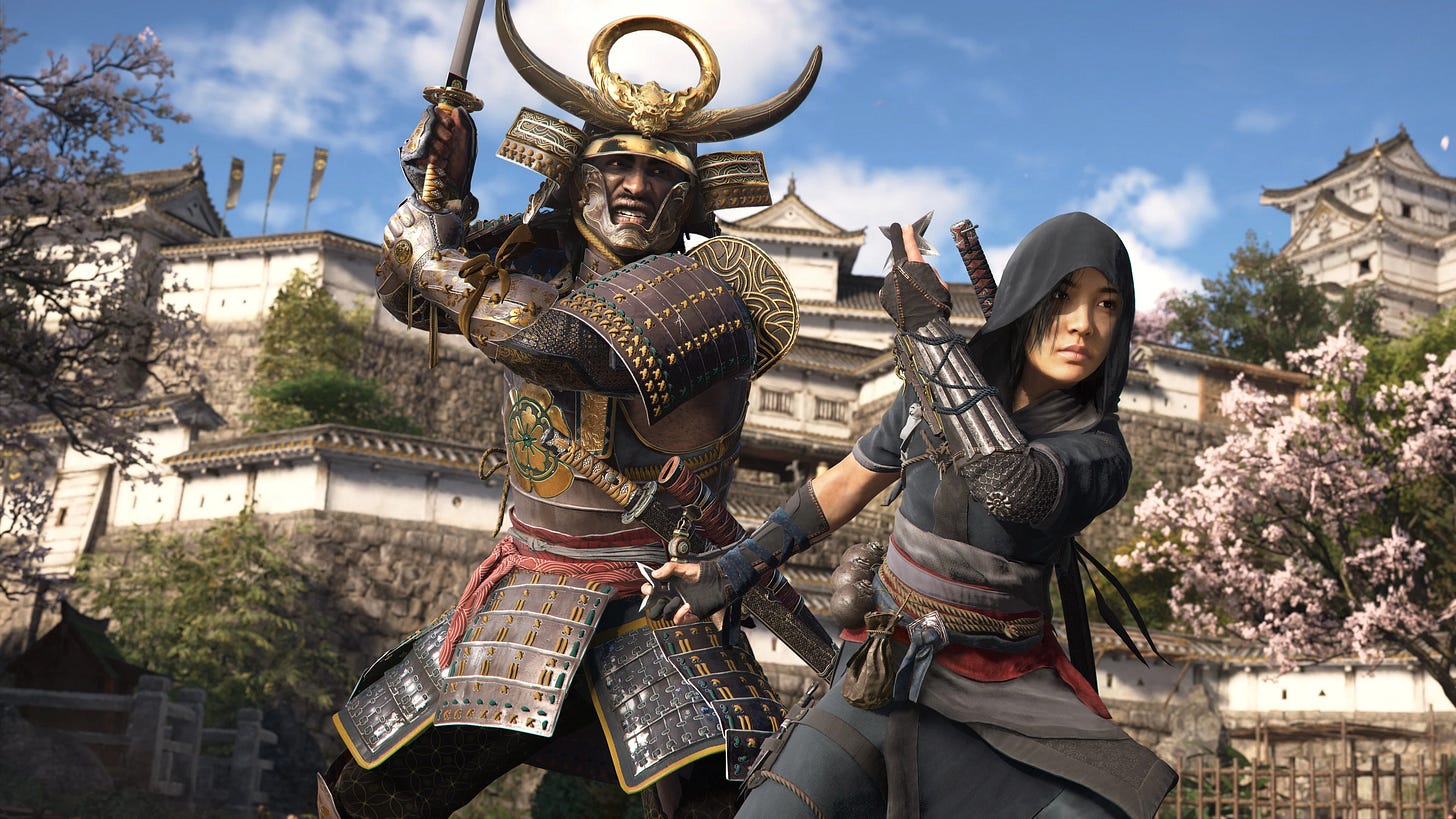
It is an unavoidable comparison.
While the Quebec-developed Syndicate had both its protagonists present from the drop of the opening title card, Shadows, their dual-protagonist follow-up, instead brings Yasuke and Naoe together much more slowly.
After an extended prologue sequence, in which both are playable, Naoe is the sole playable character from the back-half of the prologue through the entirety of the first act, until Yasuke is reintroduced and their personal stories converge.
This is a bold move, on more than one front.
From a gameplay perspective, it forces players to master the nuances of Naoe’s stealth-first style before stepping back into Yasuke’s combat boots (it took about sixteen hours, during this review, to reach that point) but most prominently, it also allows the performances of Tongayi Chirisa, as Yasuke and Masumi Tsunoda, as Naoe to exist on a truly individual level.
Each, visibly embodying the contrasting nuances of their characters, both when alone or sharing a scene together, to noticeable effect, either during the main campaign or outside it.
Many of Shadows’ smaller but most impactful side missions, they feature just Yasuke and Naoe.
They’re not fighting or plotting or scheming. Instead, maybe they’re watching ships come into the harbour, cloud gazing or sharing a drink, as they sit by the fire. Upon their initial introduction being steel-on-steel, these moments do a great deal of highlighting not just their differences but their evolving dynamic, as well.
Starting as opponents on the battlefield, to something of allies of necessity to close friends, who would put their life on the line, without hesitation, to protect the other. So while the writing team deserves their credit here of course, so to, do Chirisa and Tsunoda.
Each, bringing their characters to the screen in an actively tangible way,
And nowhere is that sense of growth more prominent than with Naoe.
In an interview with Polygon that ran last month, Tsunoda spoke about the multi-faceted journey she embarked on, playing Naoe.
From the physical challenges of on-stage performance capture, the strangeness that can often accompany the nature of video game acting (the excessive breathing, for one) or just her appreciation for her character’s arc.
And for most of the story’s early hours, Naoe makes no compromises or conditions: she is driven to avenge the death of her father, the loss of her people and will cut down anyone who gets in her way.
Her trauma, her grief, she wears them on her sleeves, manifesting as barely-contained rage, as she hunts the Shinbakufu and for a time, Nobunaga. An efficient and effective killer, in the beginning stages of their partnership, she argues with Yasuke more than once when he advocates for clemency or for personal understanding of their targets.
Naoe, struggling to see any further past her own version of righteousness.
But as the true breadth of her mission becomes clear and she finds within her League, something of an adopted family to ease the pain of what was lost, Naoe, with some effort, begins to acknowledge the humanity she never lost but clearly thought best to bury.
Lighthearted in the presence of those she cares for, with a dry sense of humour to match, there is a fierceness she just can’t shake either. She moves through the world, fiery, with a resolute confidence, learning to temper her stronger emotions but still prone to letting them loose, should they get the best of her.
This, an almost raw honesty, is something Tsunoda makes one of the highlights of her performance. Naoe, coming to find purpose beyond the unfulfilling course of bloodshed in exchange for revenge: the importance of fighting not just for others but finding peace within one’s self, as well.
The abuse of those under corruption, such problems, sometimes, simply, they just can’t be solved with a blade.
And as she extends her offer of allegiance to Hanzō, at the story’s close, it is to see that self-actualization front-and-centre.
While her mother may still be alive, it is within the sphere of larger possibility through which Naoe looks: the same lessons her father once imparted, they are now hers to pass down,
A Creed, a personal conviction, to fully call her own.
All of these elements, many running contradictory to each other for a character of such extremes, in lesser hands, they could fall apart. But Tsunoda has such command on just who Naoe is, she feels totally alive, genuine, right from the jump.
Every scream of anguish, every tear, every slowly earned moment of hard-won maturity, she brings each to great life.
Similarly, alongside her, is Chirisa: who, as Yasuke, finds a much different energy than his co-star and yet, delivers a character and performance, just as rich in depth and detail.
Immediately setting Yasuke apart from every other Assassin’s Creed protagonist is that he is the first real-life historical individual, in a main title, to be a fully playable character (for those keeping score at home, Jack the Ripper was a secondary protagonist in Syndicate’s same-named DLC, while Leonidas of Sparta was playable in Odyssey’s prologue sequence).
Though as the team discussed in Shadows’ promotional material, while there isn’t much on record regarding the real Yasuke, besides the broad strokes, it is that ambiguity which makes him such a great choice for the AC playground.
The series has always taken real-world history as a jumping off point for its stories, be it by fictionalizing the assassination of Julius Caesar to suit its own narrative ends (yes) or revealing Adam and Eve of Biblical legend wagged a war against the franchise’s over-arching, humanity-creating super-species (again, yes, disbelieve at your own peril).
And while Yasuke’s presentation, to be clear, is very much grounded in something more visibly tactile instead, it is Chirisa, right from the opening of Shadows, that gives him that weight.
Caring and considerate, perceptive but not rash, polite but not too soft-spoken.
He fights for justice because as a former slave, he has experienced, first hand, the most horrific of injustices and strives to make sure no others suffer under the foot of corruption in his new home. And yet, he doesn’t shy from the paradox present from such a line of thinking either. His former daimyō and mentor in Nobunaga, considered a bloodthirsty tyrant by many, including Naoe: whom he often looks to guide away from her impulses of action first.
For Yasuke, though a strong and capable warrior as he is, recognizes however much he has adapted to life in Japan, learning the language, social customs and religion, he will always be viewed as an outsider, even more so than the Portuguese. Chirisa’s delivery in these moments, it is spot on, the weight Yasuke carries, clear on his shoulders.
Even bandits encountered in the far reaches, they know his name. Citizens bow as he passes by. Everyone, it seems, knows his story.
Expect they don’t, not entirely, not even his closet allies.
And paired with his flashback sequences at the start of the second act, as Yasuke hunts the Templars terrorizing Japan, Chirisa owns every inch of the screen, bringing not an anger but a cold focus to his portrayal.
He will avenge his mother, that is certain, as he couldn’t defend her before. But it goes well further than that, the torment the Templars and any of their kind inflict, he simply will not allow it to stand. Once, he was saved by an Assassin. And though he does not carry the same weapons or even wear their insignia, he finds, as Naoe does, a deep purpose in their Creed.
To carry it forward with him, he will, whatever the cost, Chirisa, making sure each beat lands with impact.
Outro
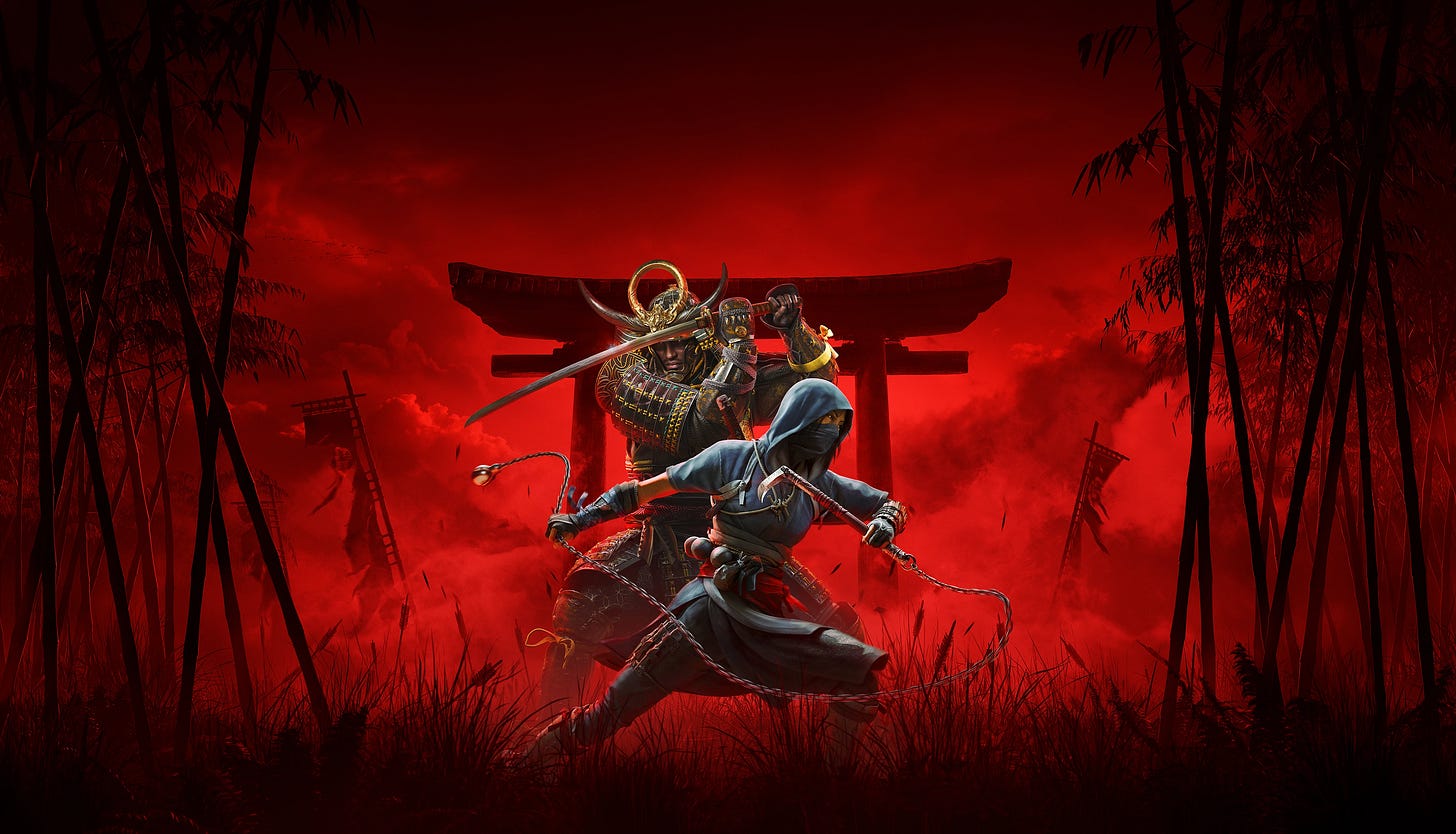
Like anything, Shadows must be viewed and graded on something of a curve.
Its open world, while visually impressive, struggles to maintain long-form interest given its weak amount of activities, while portions of its storytelling acumen (the modern day, the second act, the baked-in cliffhanger) can fall short, especially, fair or not, when compared to the game’s predecessors. There are no proper memory corridors and without player intervention, the gameplay difficulty quickly drops off.
But it is elevated. The strongest aspects of the game, outshining the rest.
The linear storytelling and character work are consistently, emotionally engaging, the combat and stealth mechanics, paired together, are possibly some of the series’ best and the performances, from the more prominent supporting cast to the leads, are bursting with skill and commitment.
For all the noise that surrounded it prior to release, Shadows proves it only ever needed to be judged on its own terms. And doing so reveals a project not without fault but wholly worthy of its praise.
Stepping out from the dark, into the light.





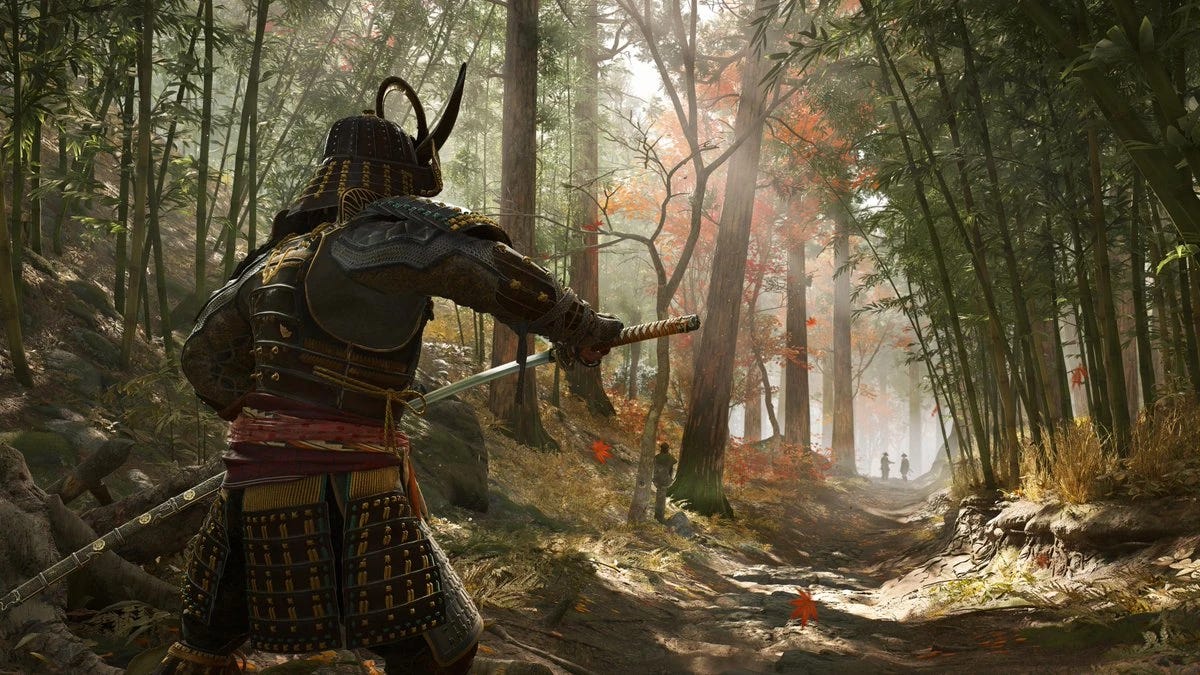
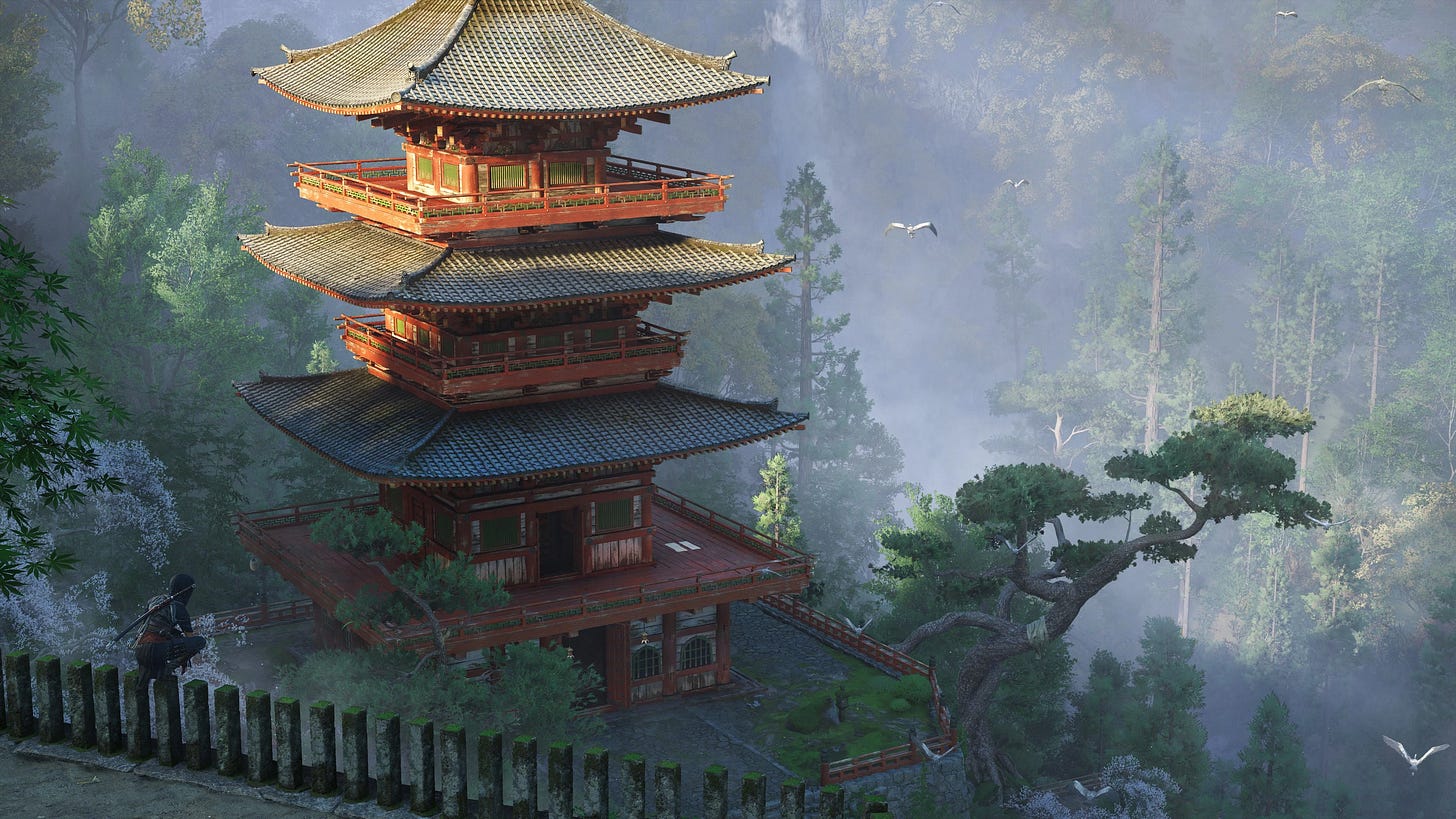
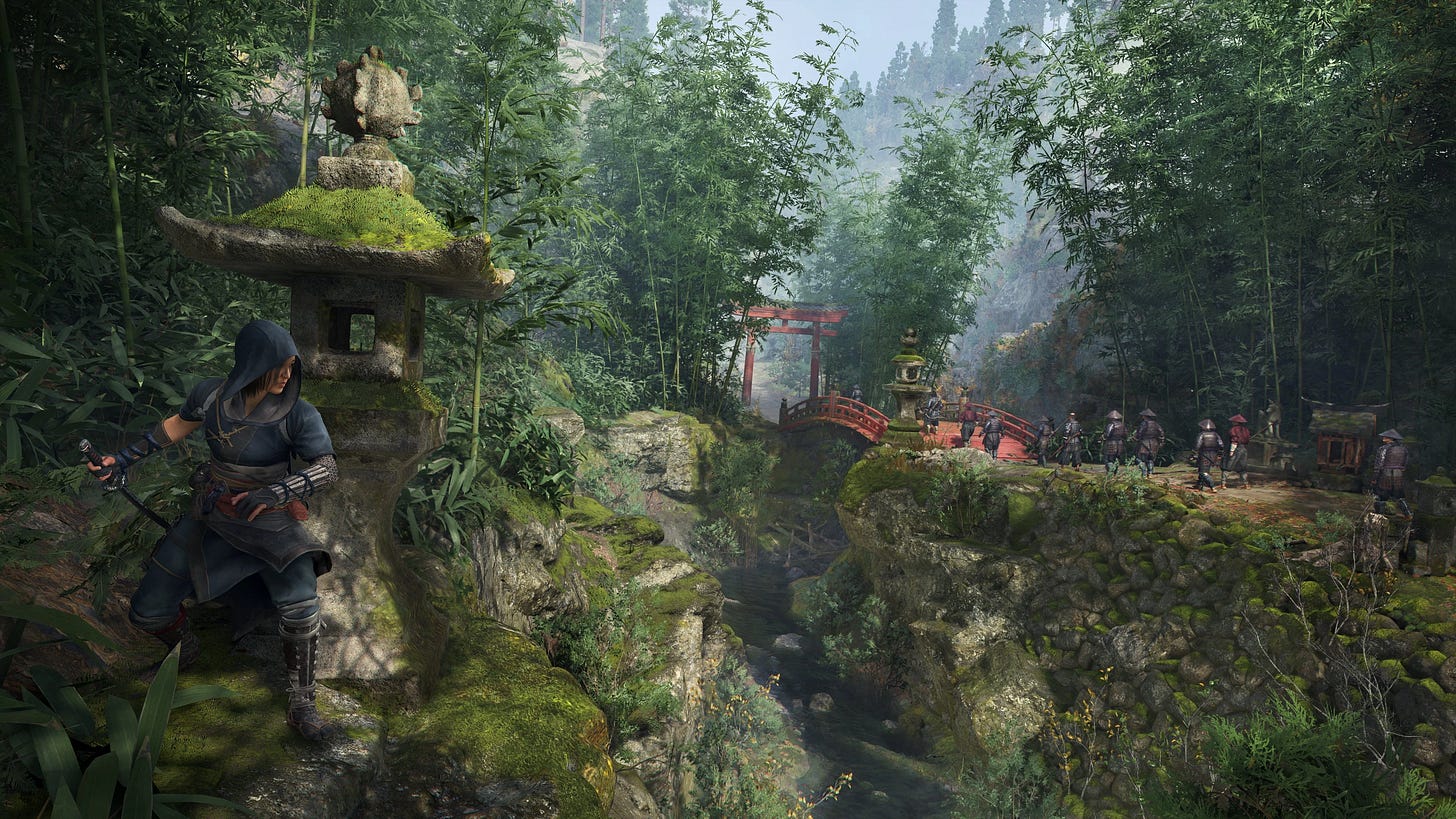
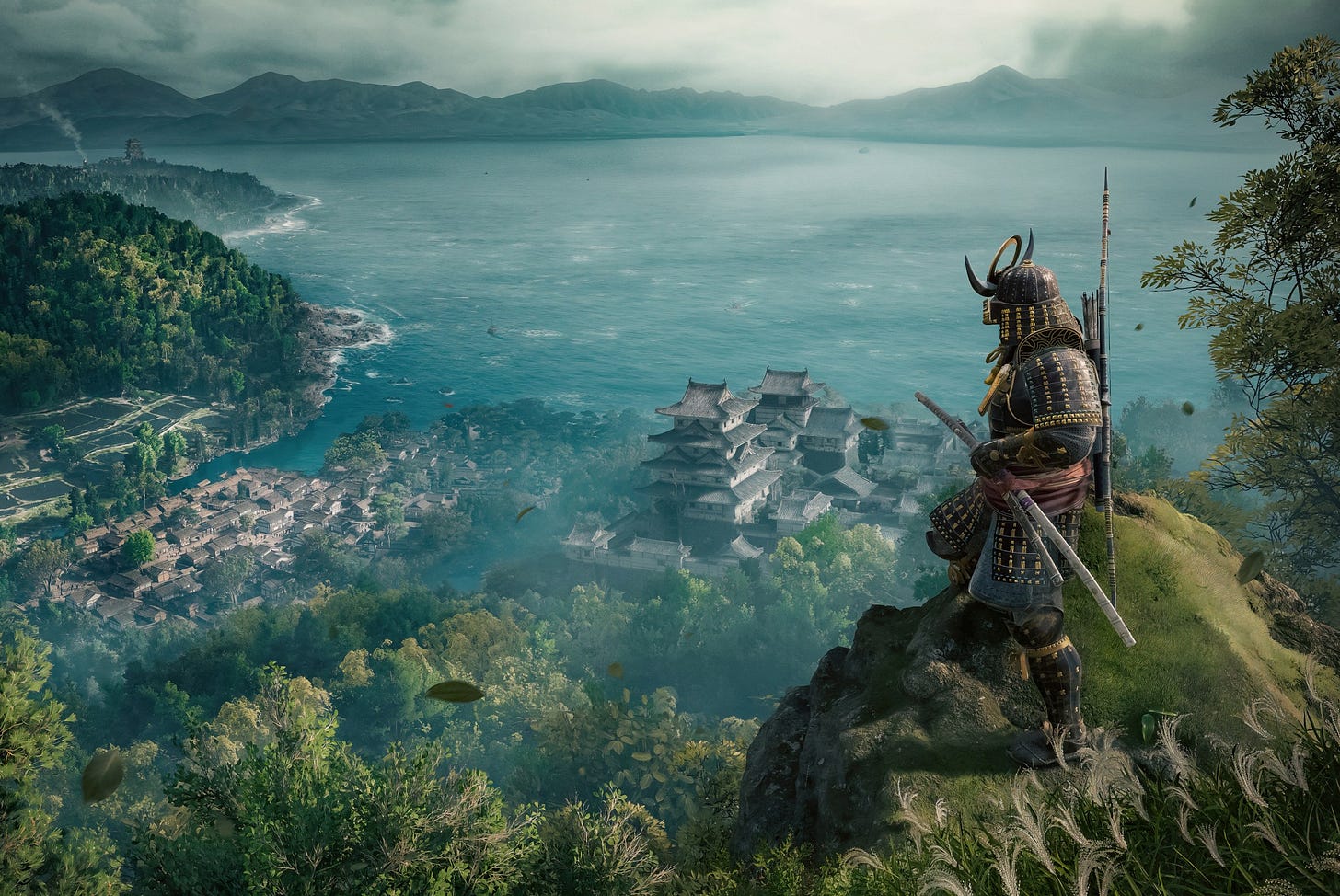
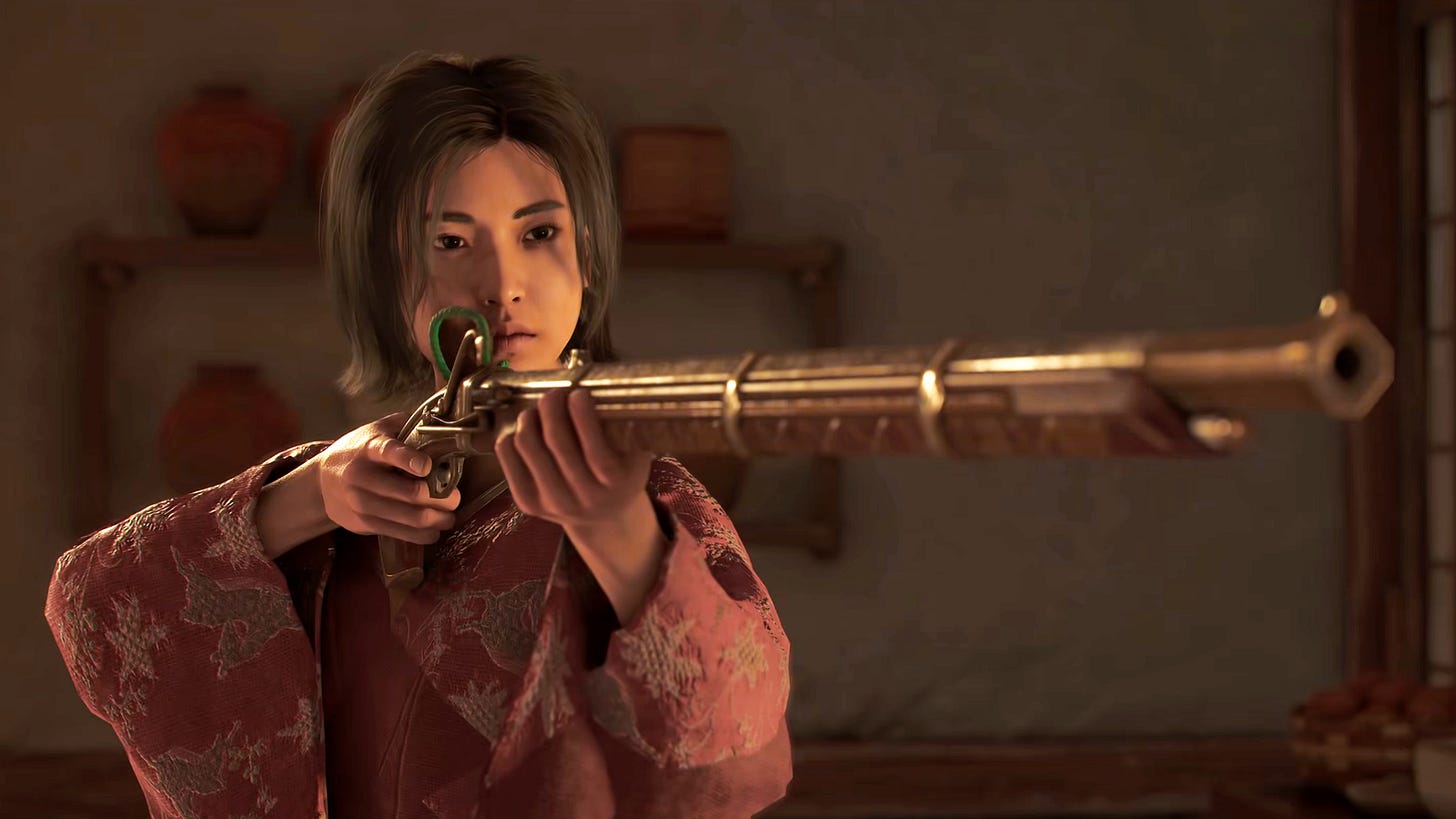
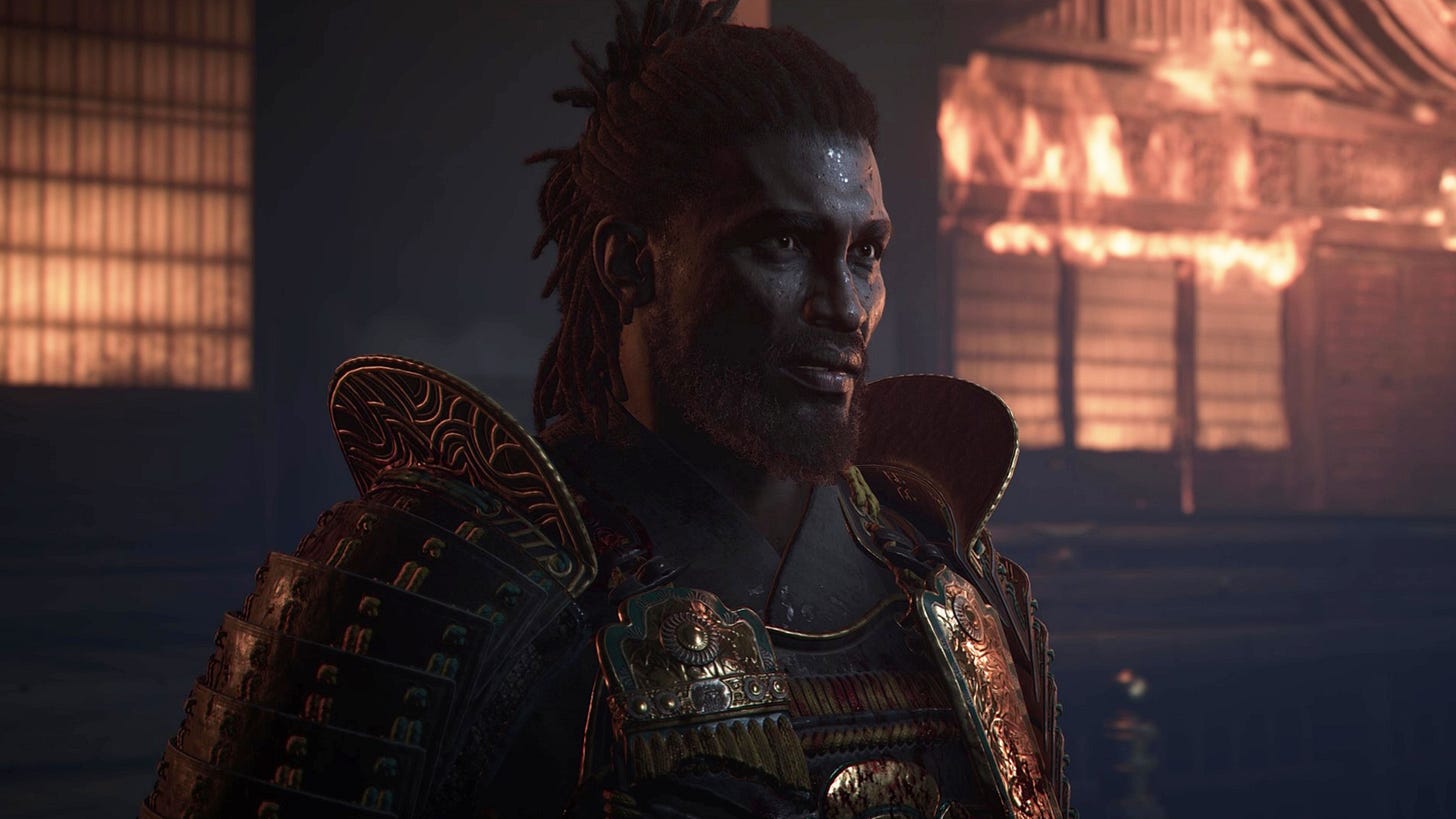
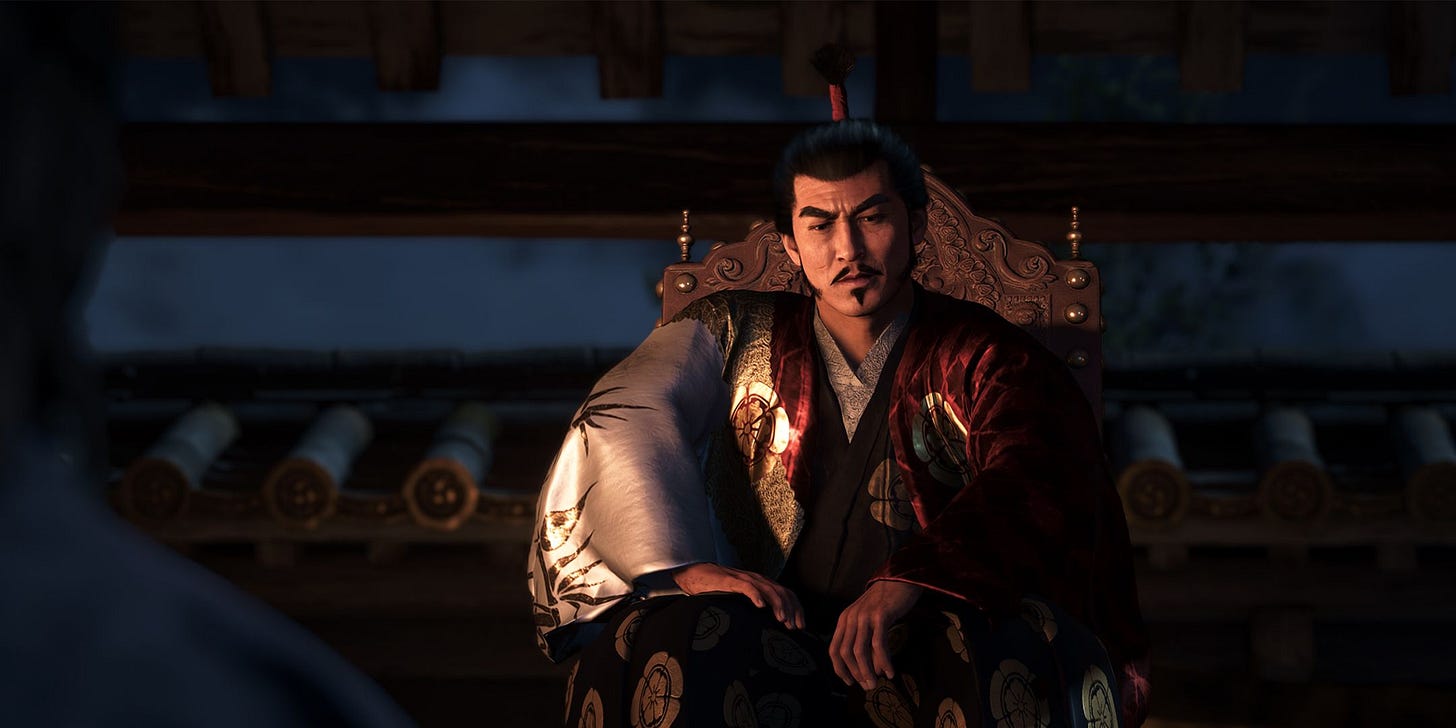
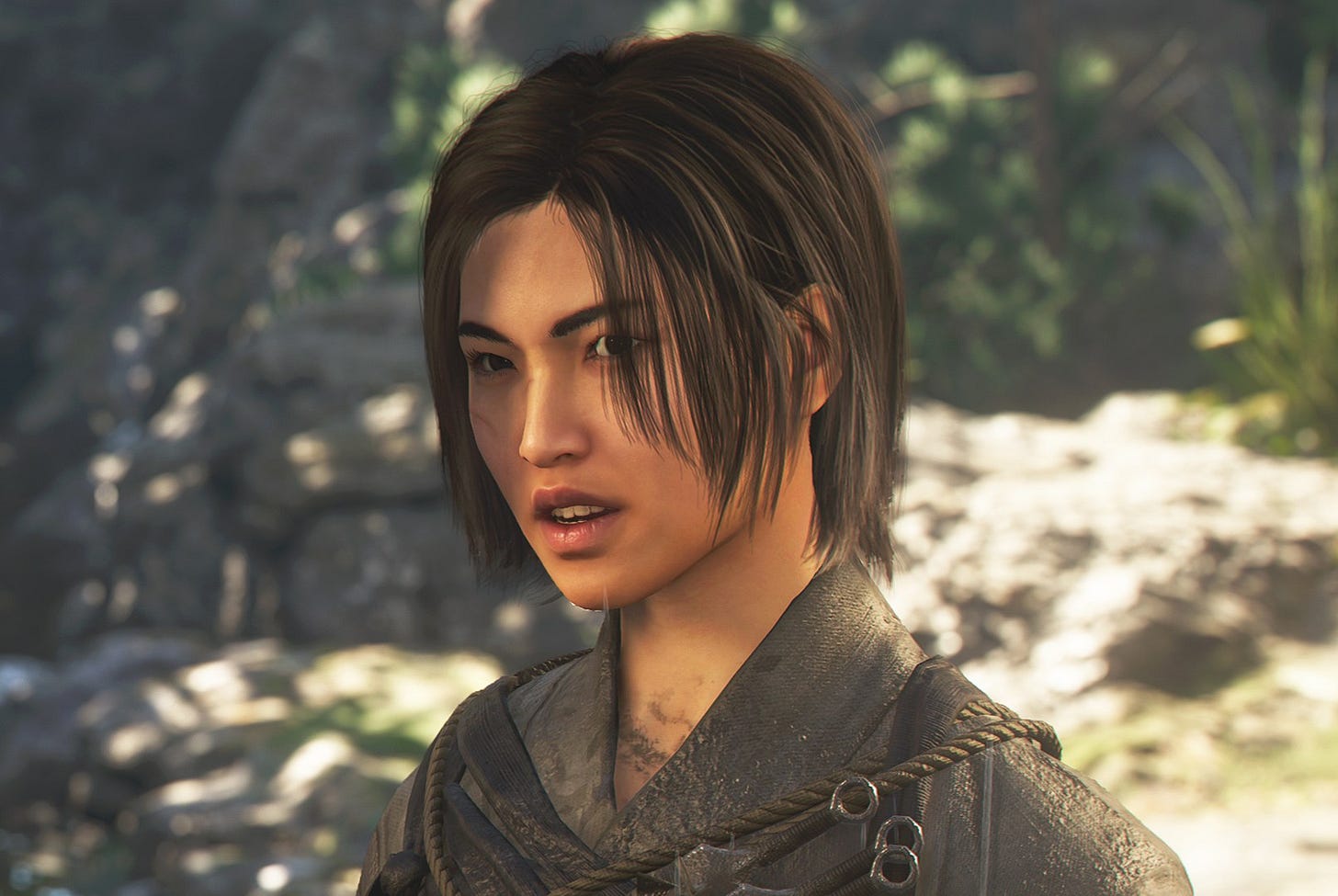
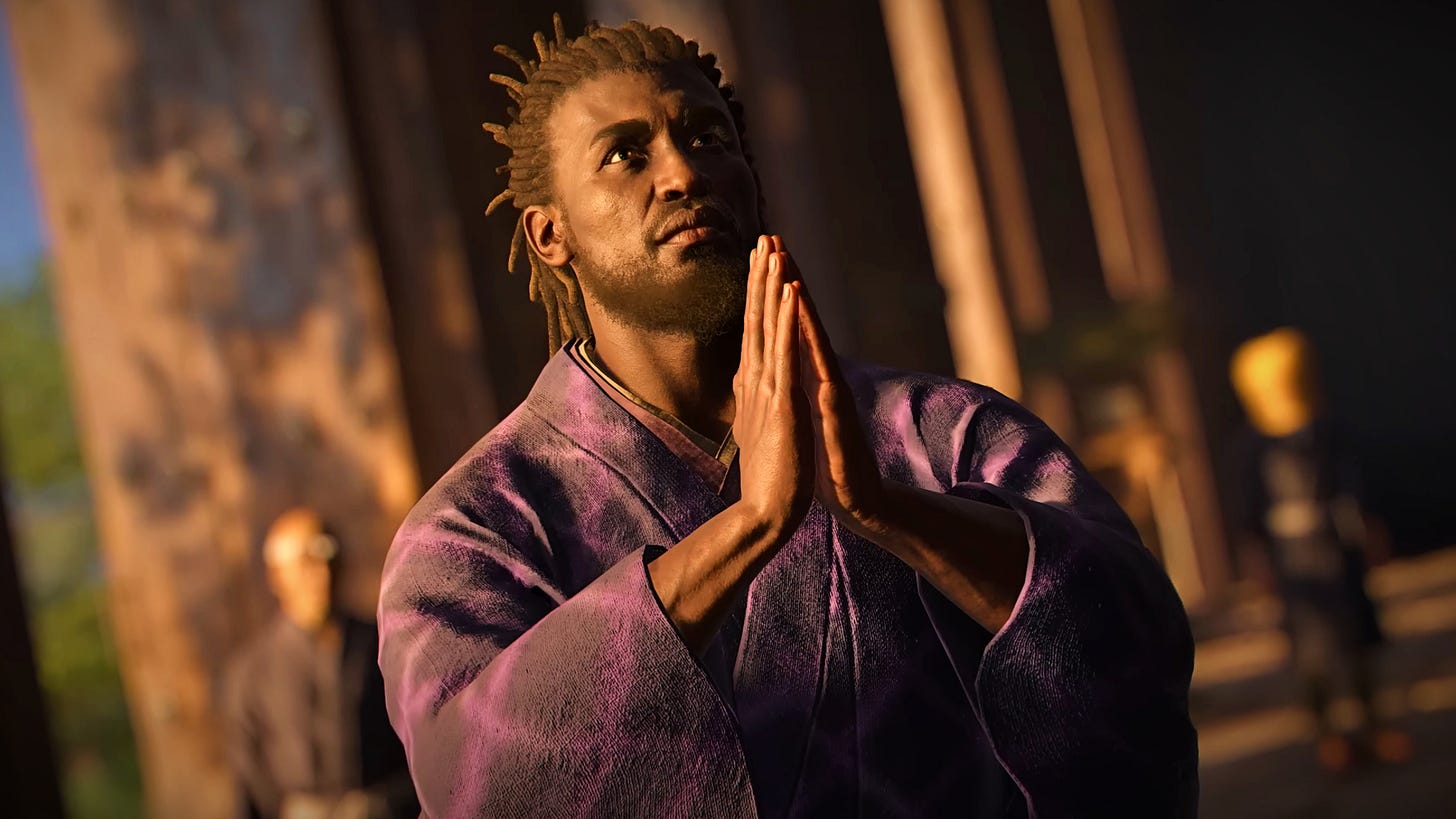
Fantastic in-depth review of the game!! I had hoped to wait for a sale to purchase, but after reading this I’d like to start playing ASAP